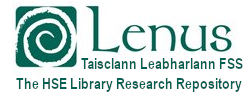Ireland's central source for Open Access health research:
Lenus contains the research output of Health Service Executive (HSE) and over 130 other organisations in Ireland. Anyone who has conducted health related research in an institution or health organisation in Ireland, can upload their published research to Lenus by clicking ‘Submit Research’.
HSE Open Access Research Awards 2025
The 12th annual HSE Open Access Research Awards are now open for entries.
The awards are judged across the following categories:
Acute Care and Hospitals
Community and Social Care
Mental Health and Disabilities
Integrated Services
Entries will be reviewed by a panel of judges with research experience. There will be a prize for each category, and an overall winner will also be selected, representing the best of all submissions received.
A special Innovation prize will be awarded to recognise outstanding recent developments in practice or service delivery.
Winners will receive a custom piece of glassware celebrating their achievement.
Criteria for Entry
- The research must have been published within the two years (24 months) prior to the closing date
- The research must be available in full text in an Open Access forum (and added to the Lenus repository as a condition of entry)
- At least one author must be working for or on behalf of the Irish health services
Entries close on Friday October 24th 2025 and the winners will be announced in early December. For more information, email lenus@hse.ie.
